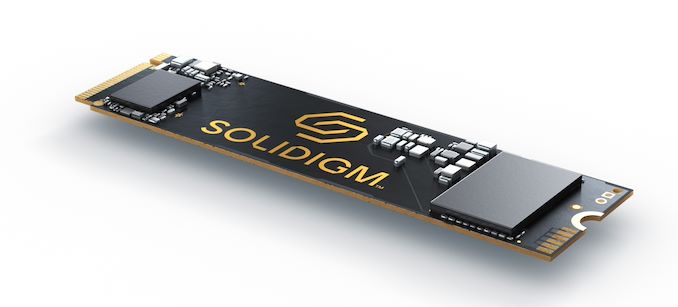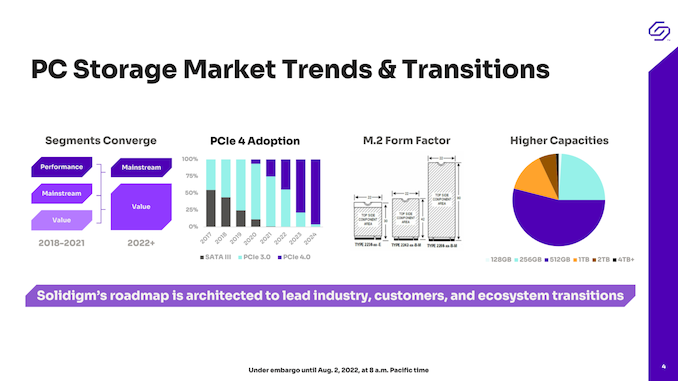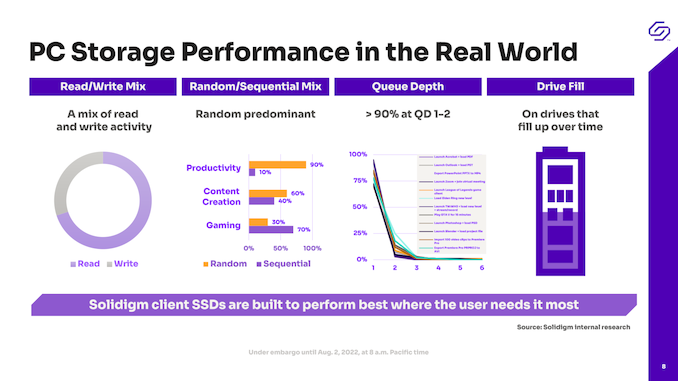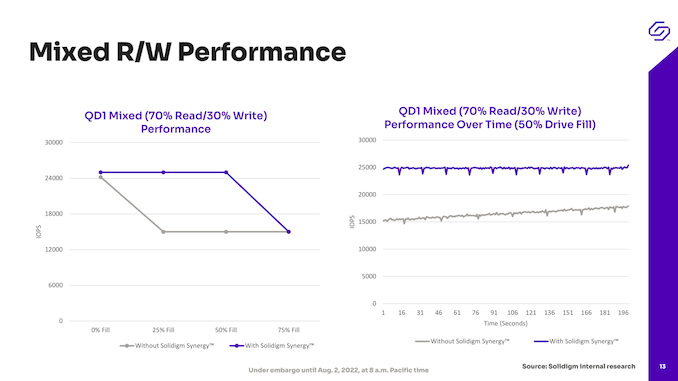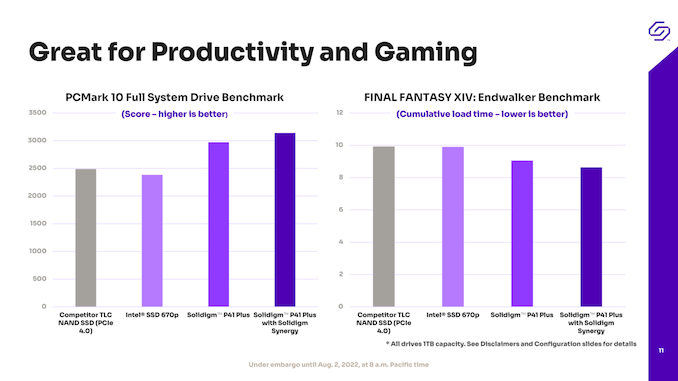Although Intel is no longer directly in the SSD market these days, their SSD team and related technologies continue to live on under the SK hynix umbrella as Solidigm. Since their initial formation at the very end of 2021, Solidigm has been in the process of reestablishing their footing, continuing to sell and support Intel’s previous SSD portfolio while continuing development of their next generation of SSDs. On the enterprise side of matters this recently culminated in the launch of their new D7 SSDs. Meanwhile on the consumer side of matters, today at Flash Memory Summit the company is announcing their first post-Intel consumer SSD, the Solidigm P41 Plus
The P41 Plus is, at a high level, the successor to Intel’s 670p SSD, the company’s second-generation QLC-based SSD. And based on that description alone, a third generation QLC drive from Soldigm is something that few AnandTech readers would find remarkable. QLC makes for cheap high(ish) capacity SSDs, which OEMs love, while computing enthusiasts are decidedly less enthusiastic about them.
But then the P41 Plus isn’t just a traditional QLC drive.
One of the more interesting ventures out of Intel’s time as a client SSD manufacturer was the company’s forays into cache tiering. Whether it was using flash memory as a hard drive cache, using 3D XPoint as a hard drive cache, or even using 3D XPoint as a flash memory cache, Intel tried several ways to speed up the performance of slower storage devices in a cost-effective manner. And while Intel’s specific solutions never really caught on, Intel’s core belief that some kind of caching is necessary proved correct, as all modern TLC and QLC SSDs come with pseudo-SLC caches for improved burst write performance.
While they are divorced from Intel these days, Solidigm is picking up right where Intel left off, continuing to experiment with cache tiering. Coming from the same group that developed Intel’s mixed 3D XPoint/QLC drives such as the Optane Memory H20, Solidigm no longer has access to Intel’s 3D XPoint memory (and soon, neither will Intel). But they do have access to flash memory. So for their first solo consumer drive as a stand-alone subsidiary, Solidigm is taking a fresh stab at cache tiering, expanding the role of the pSLC cache to serve as both a write cache and a read cache.
P41 Plus Hardware: The “Plus” Stands For Value
But before we dive too much into Solidigm’s latest caching configuration, let’s talk about the hardware itself.
The Solidigm P41 Plus, codenamed Echo Harbor, is a PCIe 4.0 x4 QLC SSD that is based around what is now Solidigm’s 144L QLC NAND. Increasingly typical for budget QLC drives, this is a DRAMless design, so it relies om Host Memory Buffer (HMB) to store the translation tables.
Driving the new SSD is Silicon Motion’s SM2269XT controller. Released a bit earlier this year, the SM2269XT is by and large an updated version of the SM2267XT, and serves as the company’s mainstream 4-channel DRAMless controller. Built on a 12nm process, the SM2269XT supports NAND transfer rates up to 1600 MT/s, and is designed to be paired with either TLC or QLC NAND. Meanwhile for host connectivity, the 2269XT offers four lanes of PCIe 4.0, and supports the NVMe 1.4 standard.
| Solidigm P41 Plus Specifications | |||||
| Capacity | 512 GB | 1 TB | 2 TB | ||
| Controller | Silicon Motion SM2269XT | ||||
| NAND Flash | Solidigm 144L 3D QLC | ||||
| DRAM | None/HMB | ||||
| Form-Factor, Interface | Single-sided M.2-2280/42/30 PCIe 4.0 x4, NVMe 1.4 |
||||
| Sequential Read (MB/s) |
3500 | 4125 | 4125 | ||
| Sequential Write (MB/s) |
1625 | 2950 | 3325 | ||
| Random Read IOPS |
115k | 225k | 390k | ||
| Random Write IOPS |
540k? | 540k? | 540k | ||
| Power | Active | 80mW | |||
| Idle | 25mW | ||||
| Warranty | 5 years | ||||
| Write Endurance | 200 TBW 0.2 DWPD |
400 TBW 0.2 DWPD |
800 TBW 0.2 DWPD |
||
| pSLC Cache | 8 GB | 16 GB? | 32 GB? | ||
| 75 GB | 150 GB | 300 GB | |||
As this drive is essentially the successor to the Intel 670p, down to using the same 144L NAND, it ends up coming in the same three capacities: 2TB, 1TB, and 512GB. Relative to the 670p, Solidigm has turned up the pSLC cache sizes a bit; the drives offer a maximum of 75GB, 150GB, and 300GB of SLC cache respectively, which diminishes as the drive fills.
Because it lacks any DRAM, the P41 Plus is even more of a budget drive than its predecessors. Whereas the 660p and 670p come with DRAM, the P41 Plus is the first Intel/Solidigm pure QLC drive to forego the DRAM. Solidigm is up-front that they are going after the value market with this drive, and removing the DRAM from a QLC drive is unambiguously a value play.
One of the side benefits of removing the DRAM, however, is that it reduces the amount of space taken up by the drive. As a result, for the first time Solidigm is able to offer one of their client drives in a form factor smaller than the usual 80mm long M.2 2280 form factor. As a result, the company will also be producing 2242 form factor drives in all three capacities, while the smallest 2230 form factor drive will be available in 512GB and 1TB capacities. These smaller drives are only intended for the OEM market, however, so while the 2280 drive will be sold both at retail and to OEMs, only the latter will be able to officially get their hands on the shorter drive.
Since Solidigm is still using the same 144L generation NAND for this newer product, the write endurance ratings are essentially unchanged from their previous generation products. That means a 200 TBW rating for the 512GB drive, and then 400 TBW and 800 TBW respectively for the 1TB and 2TB drives. Spread out over the 5 year warranty period for the drive, and this works out to about 0.2 drive writes per day, or an endurance rating of 400 P/E cycles.
Overall, the rated performance of the P41 Plus is higher than the preceding 670p, primarily due to the controller changes. Even with a pSLC cache, the QLC NAND is only barely fast enough to warrant PCIe 4.0 connectivity, though the sequential reads can hit 4125MB/sec. This makes for modest increases in sequential throughput, while offering a more significant improvement in random IOPS (at least as far as official ratings go).
Finally, it’s worth noting that the “P41” name is not a coincidence, despite the fact that it’s already in use elsewhere. While Solidigm is a subsidiary of SK hynix, it is part of the mega memory firm all the same. And while SK hynix’s own internal retail efforts are separate from Solidigm right now, that won’t always be the case. So, even if slowly, SK hynix is making preparations for a day where they have a single retail brand.
The end result is that the P41 Plus has been named to go along with SK hynix’s own Platinum P41 – or as it's more commonly known, just the P41. To be sure, the drives have absolutely nothing in common – everything from the NAND to the controller to the market segment is different – but SK hynix is prepared to offer them together, if they decide to go that route. Unfortunately, this is a dubious decision from a customer standpoint; whereas the (Platinum) P41 is a flagship-level drive designed for high performance, the P41 Plus is a the very opposite end of the spectrum – very “plus” indeed. Generally, suffixes are used to denote superior hardware, so it’s a very unusual day when it’s the other way around.
Soldigm Synergy: Read Caching on Windows
The hardware aside, the other major aspect of the P41 Plus – and certainly the most novel – is Soldigm’s latest attempt at cache tiering. While the company is not the first vendor to try using a pSLC write cache as a read cache as well (the Enmotus FuzeDrive takes those honors), this is the first time Solidigm has gone this route. And it’s certainly the highest profile attempt at the technique yet.
As with the Optane Memory series of drives and the Enmotus drive, the basic idea behind having a read cache is to further improve the performance of a drive with otherwise slow NAND. While going with progressively finer multi-level cells within NAND causes write performance to drop off far faster than read performance, there is still a hit. This is especially the case when it comes to random reads as well as low queue depth operations that can’t fully exploit the parallelism present in a SSD. And unfortunately, that also describes client workloads to a T.
Solidigm’s solution, then, is to treat the pSLC cache not as a write cache that’s merely used to buffer small amounts of data before it can be written to the slower QLC NAND, but rather to use the pSLC cache as a hot cache for reads and writes. That means keeping hot data (LBAs) on the pSLC cache, and only sending data to the QLC portion of the NAND when it’s either deemed no longer hot, or when the space is required (e.g. the pSLC portion is being shrunk). This works out to being very similar to how the Optane Memory H20 and its ilk operated, just replacing the Optane cache with the pSLC NAND.
The good news is that from a technical standpoint, this significantly simplifies the construction (and abstraction) of the drive. Whereas the Optane Memory H20 had the unfortunate need to show up and operate as two drives – one Optane, one QLC – the P41 Plus shows up as a single SSD. And rather than talking to two SSDs, Solidigm merely needs to provide hints to the drive’s firmware to let it know what data it should consider hot. This shuffles more of the workload behind cache tiering on to the drive controller itself.
The bad news is that special software/drivers are still required to identify hot data and provide directions to the drive controller. And that software, in turn, is Windows-only. So while the P41 Plus will work on Linux boxes and other machines, to benefit at all from Solidigm’s read caching, it needs to be running on a Windows host with Solidigm’s driver.
For the launch of the P41 Plus, Soldigm is (re)branding their software suite as Soldigm Synergy. This is comprised of their storage driver, as well as a separate storage tool that offers drive health monitoring and other SSD toolbox features. The company also refers to their overall cache tiering feature as Synergy, so the feature and the software components should not be confused.
The upshot there is that Solidigm has significant experience with caching (and caching drivers) at this point. So the company should be able to leverage the experience and code it already has from earlier products to develop their caching storage driver, as opposed to needing to come up with everything from scratch.
According to Solidigm, they do not set aside any space on the P41 Plus specifically to hold hot data for reads. So the entire capacity of the drive is always available for access, with the size of the pSLC cache dynamically altered based on how much of the drive’s capacity is in use. And while we don’t have detailed figures for each capacity of the drive, Solidigm has indicated that they only do read caching when the drive is less than half-full. After the drive is half-full, the drive shifts to operating like a more traditional QLC SSD, favoring the diminishing pSLC space for writes to reduce the painful penalty of writing directly to QLC. For the 512GB drive, the pSLC cache will go down as low as 8GB if the drive is filled, and while we don’t have formal figures for the other drives, 16GB and 32GB respectively are reasonable guesses.
As for the effectiveness of Solidigm’s read caching, based on what we’ve seen with the Optane Memory H20 and similar drives, there’s little reason to doubt that this works, at least to an extent. While detailed reviews will be needed to sort out the full performance range of the drive, we’ve already seen that throwing a fast cache in front of a DRAM-equipped QLC drive can improve performance, especially in workloads where the hot data is easily identified. The catch will be that QLC in pSLC mode is not 3D XPoint, so while it’s faster than QLC, it won’t be able to offer the same kind of absurd random read performance as Intel’s soon-to-be-retired phase change memory.
Solidigm’s own promotional material shows modest improvements. Mixed read/write (70/30) workloads at QD1 measured with iometer show a 66% improvement in IOPS, reaching 25K. Pure random reads improve a bit more, going up by 72% to around 18K IOPS.
To be sure, neither of these figures is fantastic, however for a QLC drive they are respectable, and above what the more traditional drives like the 670p have delivered in our testing.
Solidigm also has some slightly more real-world benchmarks, which have the P41 Plus performing well in the very cache-friendly PCMark 10 Full System Drive test. Solidigm also includes an unnamed TLC drive, but without more information it’s hard to say anything of value – or even confirm if it was a meaningful test.
A win for Solidigm, in any case, doesn’t mean delivering chart-topping performance. If the P41 can hide the lack of DRAM and still being able to beat other QLC/TLC drives that are competing in the value segment alongside the P41 Plus, then that’s a win for Solidigm.
Closing Thoughts
Wrapping things up, while Solidigm isn’t announcing a launch date for the P41 Plus this morning, based on early retail listings we should expect to see the new QLC drive family sooner than later. The big question, as is usually the case with QLC drives, is at what price. QLC drives are still at a fundamental technical disadvantage compared to TLC drives, so even with the potential benefits of a better caching solution, the P41 Plus family still needs to be priced competitively. As with Intel and Solidigm’s previous QLC drives, pricing is going to make or break things in the retail market.


 2 years ago
118
2 years ago
118
